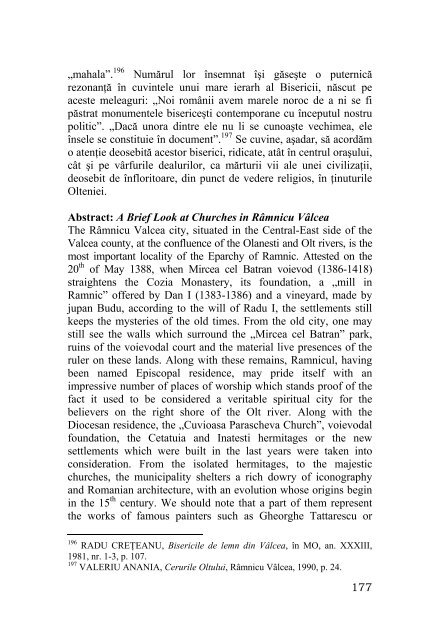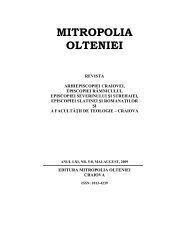revista arhiepiscopiei craiovei, arhiepiscopiei râmnicului, episcopiei ...
revista arhiepiscopiei craiovei, arhiepiscopiei râmnicului, episcopiei ...
revista arhiepiscopiei craiovei, arhiepiscopiei râmnicului, episcopiei ...
You also want an ePaper? Increase the reach of your titles
YUMPU automatically turns print PDFs into web optimized ePapers that Google loves.
„mahala”. 196 Numărul lor însemnat îşi găseşte o puternică<br />
rezonanţă în cuvintele unui mare ierarh al Bisericii, născut pe<br />
aceste meleaguri: „Noi românii avem marele noroc de a ni se fi<br />
păstrat monumentele bisericeşti contemporane cu începutul nostru<br />
politic”. „Dacă unora dintre ele nu li se cunoaşte vechimea, ele<br />
însele se constituie în document”. 197 Se cuvine, aşadar, să acordăm<br />
o atenţie deosebită acestor biserici, ridicate, atât în centrul oraşului,<br />
cât şi pe vârfurile dealurilor, ca mărturii vii ale unei civilizaţii,<br />
deosebit de înfloritoare, din punct de vedere religios, în ţinuturile<br />
Olteniei.<br />
Abstract: A Brief Look at Churches in Râmnicu Vâlcea<br />
The Râmnicu Valcea city, situated in the Central-East side of the<br />
Valcea county, at the confluence of the Olanesti and Olt rivers, is the<br />
most important locality of the Eparchy of Ramnic. Attested on the<br />
20 th of May 1388, when Mircea cel Batran voievod (1386-1418)<br />
straightens the Cozia Monastery, its foundation, a „mill in<br />
Ramnic” offered by Dan I (1383-1386) and a vineyard, made by<br />
jupan Budu, according to the will of Radu I, the settlements still<br />
keeps the mysteries of the old times. From the old city, one may<br />
still see the walls which surround the „Mircea cel Batran” park,<br />
ruins of the voievodal court and the material live presences of the<br />
ruler on these lands. Along with these remains, Ramnicul, having<br />
been named Episcopal residence, may pride itself with an<br />
impressive number of places of worship which stands proof of the<br />
fact it used to be considered a veritable spiritual city for the<br />
believers on the right shore of the Olt river. Along with the<br />
Diocesan residence, the „Cuvioasa Parascheva Church”, voievodal<br />
foundation, the Cetatuia and Inatesti hermitages or the new<br />
settlements which were built in the last years were taken into<br />
consideration. From the isolated hermitages, to the majestic<br />
churches, the municipality shelters a rich dowry of iconography<br />
and Romanian architecture, with an evolution whose origins begin<br />
in the 15 th century. We should note that a part of them represent<br />
the works of famous painters such as Gheorghe Tattarescu or<br />
196<br />
RADU CREŢEANU, Bisericile de lemn din Vâlcea, în MO, an. XXXIII,<br />
1981, nr. 1-3, p. 107.<br />
197<br />
VALERIU ANANIA, Cerurile Oltului, Râmnicu Vâlcea, 1990, p. 24.<br />
177




